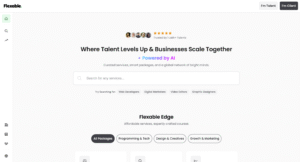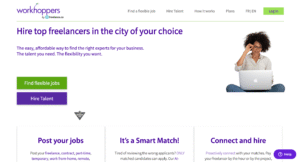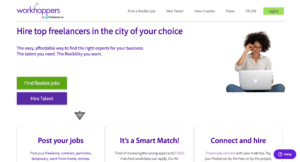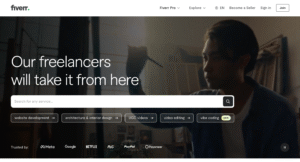Freelancing in Canada continues to grow in 2025 as more professionals choose independent work for flexibility, better work-life balance, and new career opportunities. Businesses across the country, from startups to large corporations, are also embracing freelancers to access specialized talent without long-term commitments. This creates strong demand in fields like IT, design, writing, marketing, and consulting.
With so many platforms available, the key challenge is knowing where to focus. Some platforms are based in Canada and connect freelancers with local clients, while others are global marketplaces that provide access to international projects. The right platform can make a big difference in the type of clients you work with and the career opportunities you build.
In this guide, we explore the 10 best freelance websites in Canada for 2025. Each one offers unique benefits, and the best fit depends on your skills and goals.

Flexable Canada
Flexable is a growing freelancing platform that is expanding into North America, including Canada. Unlike platforms that focus only on short-term gigs, Flexable emphasizes larger and collaborative projects where freelancers can work independently or as part of teams. The platform also supports agencies, making it a versatile choice for professionals who want to scale their freelance careers. For Canadian freelancers looking for consistency and higher-value contracts, Flexable is a strong option.
Highlights and Key Features
- Curated onboarding to vet freelancers and clients.
- Easy workflow from profile setup to milestone payments.
- Built-in communication and project tracking tools.
- AI-powered recommendations for relevant jobs.
- Supports both individual freelancers and agencies.
Pros
- Expanding presence in Canada and North America.
- Focus on long-term and higher-value opportunities.
- Curated process helps reduce low-quality jobs.
- Integrated project management simplifies collaboration.
Cons
- Still growing, with a smaller client base than global platforms.
- Limited global recognition compared to leaders like Upwork.
- Reach outside its core markets is still developing.

Workhoppers
Workhoppers is a Canada-based freelancing platform that connects local businesses with freelancers and consultants. It focuses on flexible work arrangements, including short-term projects, part-time roles, and remote contracts. Unlike global platforms, Workhoppers emphasizes local connections, making it easier for Canadian freelancers to work with nearby clients. For professionals in fields like marketing, IT, admin, and design, Workhoppers is a practical choice for building client relationships within Canada.
Highlights and Key Features
- Dedicated to the Canadian freelance market.
- Covers a wide range of industries, from admin to creative services.
- Local focus makes it easier to connect with nearby clients.
- Flexible opportunities including part-time and short-term contracts.
- Simple, profile-driven matching system.
Pros
- Strong local presence in Canada.
- Great for building long-term relationships with Canadian clients.
- Covers multiple industries, not limited to tech or creative.
- Beginner-friendly with straightforward onboarding.
Cons
- Smaller scale compared to global freelancing platforms.
- Limited international exposure.
- Lower project volume than giants like Upwork.
- Some opportunities may lean toward short-term or lower-budget work.

Guru
Guru is a global freelancing platform that has built a strong user base in Canada thanks to its lower service fees and flexible payment options. It connects freelancers with clients across industries such as IT, design, writing, marketing, and business consulting. One of Guru’s standout features is its SafePay system, which ensures secure payments and builds trust between freelancers and clients. For Canadian professionals seeking steady work without the high commission rates of other platforms, Guru is a dependable option.
Highlights and Key Features
- Wide coverage across multiple industries.
- SafePay escrow system for secure transactions.
- Flexible payment terms: hourly, milestone, or per project.
- Built-in WorkRoom for managing communication and files.
- Lower commission fees (5–9%) compared to many competitors.
Pros
- Lower fees mean more earnings for freelancers.
- Flexible payment structures suit different types of projects.
- Built-in collaboration tools make project management simple.
- Secure escrow system protects both freelancers and clients.
Cons
- Smaller project volume compared to platforms like Upwork or Fiverr.
- User interface feels less modern than newer platforms.
- Less brand visibility among top-tier clients.
- Opportunities may lean more toward small and medium projects.

Jooble
Jooble is a global job search engine that aggregates freelance, part-time, and full-time opportunities from multiple sources. In Canada, it is widely used to discover freelance projects across industries like IT, writing, design, customer service, and marketing. Unlike traditional freelancing platforms, Jooble redirects freelancers to the original job postings, so you manage contracts and payments directly with clients. For Canadian freelancers looking to cast a wide net, Jooble is a useful tool for finding opportunities in one place.
Highlights and Key Features
- Aggregates freelance jobs from multiple sources.
- Advanced filters for industry, contract type, and pay range.
- Covers a wide variety of categories.
- Free to use with no membership fees.
- Company profiles help freelancers research potential employers.
Pros
- Broad access to freelance and contract opportunities.
- Easy to search and filter for relevant jobs.
- No commission fees on earnings.
- Great for freelancers seeking both local and remote work.
Cons
- Does not handle payments or contracts.
- Job quality can vary since listings come from external sources.
- No built-in project management tools.
- Requires freelancers to manage client agreements independently.

Upwork
Upwork is one of the largest freelancing platforms in the world and is widely used by Canadian freelancers. It connects professionals with clients globally in industries such as IT, design, writing, customer service, and marketing. Upwork supports both short-term gigs and long-term contracts, making it flexible for freelancers at different stages of their careers. For Canadian freelancers, it provides access to international clients and higher-value projects, as well as opportunities with local businesses.
Highlights and Key Features
- Massive global marketplace with millions of projects.
- Wide coverage across professional categories.
- Escrow-secured payments for financial safety.
- AI-powered job recommendations for relevant matches.
- Collaboration tools including chat, time tracking, and file sharing.
Pros
- Huge variety of projects across industries.
- Flexible contract types (hourly or milestone-based).
- Trusted platform with strong payment protection.
- Suitable for both beginners and experienced freelancers.
Cons
- High competition, especially in popular categories.
- Service fees start at 20% for the first $500 earned with a client.
- Proposals require “Connects” (paid credits).
- Building visibility takes time in a crowded marketplace.

Fiverr
Fiverr is a global freelancing marketplace that is widely used in Canada, especially by creative professionals. It uses a gig-based model where freelancers create service listings with fixed prices, and clients can purchase directly. This setup makes Fiverr beginner-friendly and especially appealing for repeatable services such as design, writing, video editing, and marketing. With its global reach, Fiverr allows Canadian freelancers to attract both local and international clients without competing in bidding systems.
Highlights and Key Features
- Gig-based marketplace with tiered pricing packages.
- Fiverr Neo, an AI tool, improves freelancer-client matching.
- Portfolio features to showcase past work.
- Reviews and ratings build credibility and visibility.
- Direct messaging system for client communication.
Pros
- Easy to set up and beginner-friendly.
- Transparent pricing that clients can see upfront.
- Strong international exposure.
- Good for repeatable creative and digital services.
Cons
- 20% commission fee on all earnings.
- Highly competitive in popular categories.
- Price-driven marketplace can limit premium rates.
- Heavy reliance on reviews for visibility and growth.

Freelancer.com
Freelancer.com is one of the most established freelancing platforms and is widely used by Canadian freelancers. It connects millions of professionals with clients across industries like IT, design, writing, marketing, and admin support. The platform offers two ways to find work: freelancers can bid on projects or take part in contests where clients select the best submission. This flexibility makes Freelancer.com useful for both beginners who want to showcase their skills and experienced freelancers seeking steady work.
Highlights and Key Features
- Global marketplace with millions of registered users.
- Dual earning model: bidding and contests.
- Escrow-secured payments for safety.
- Milestone tracking and progress management tools.
- Membership tiers for more bids and added visibility.
Pros
- Large variety of jobs across multiple industries.
- Contest model provides opportunities to showcase skills.
- Secure escrow system ensures reliable payments.
- Suitable for both beginners and professionals.
Cons
- Intense competition, which can drive rates lower.
- Free plan restricts the number of bids available.
- Service fees reduce overall earnings.
- Project quality varies widely depending on clients.

Toptal
Toptal is a premium freelancing network that connects the top three percent of freelancers with high-value clients worldwide. It is best known for industries like software development, design, finance, and project management. Unlike open marketplaces, Toptal uses a strict screening process with technical tests, interviews, and portfolio reviews. For highly skilled freelancers in Canada, Toptal provides access to long-term, well-paid projects with startups and established global companies.
Highlights and Key Features
- Rigorous vetting process to ensure quality.
- Fast client matching, often within 48 hours.
- High-paying contracts, typically $100–$250 per hour.
- Secure and reliable payment system.
- Focused on professional, long-term opportunities.
Pros
- Access to premium global clients.
- Strong credibility from selective entry.
- Consistent long-term opportunities.
- Faster matching compared to bidding platforms.
Cons
- Very selective, only a small percentage are accepted.
- Limited categories outside tech, design, and finance.
- Not suitable for beginners or those building portfolios.
- Lengthy and demanding application process.

LinkedIn Services Marketplace
LinkedIn Services Marketplace is built into the world’s largest professional networking platform, giving Canadian freelancers the chance to promote their services directly on their LinkedIn profiles. Instead of bidding or listing gigs, freelancers attract clients through their visibility, recommendations, and professional network. This makes it especially valuable for consultants, marketers, writers, and designers who want to leverage personal branding. While it does not manage payments or contracts, LinkedIn provides strong credibility and access to both local and international clients.
Highlights and Key Features
- Service listings integrated into LinkedIn profiles.
- Visibility through LinkedIn search and job board.
- Endorsements and recommendations increase trust.
- Free to use with optional premium upgrades.
- Content sharing boosts inbound client opportunities.
Pros
- Strong professional credibility through LinkedIn.
- Great for building long-term client relationships.
- Free to start and easy to use.
- Connects with Canadian and international clients.
Cons
- No built-in payment or project management system.
- Freelancers must handle billing independently.
- Success depends on profile quality and activity.
- Less structured than dedicated freelancing platforms.

PeoplePerHour
PeoplePerHour is a UK-based freelancing platform that has built a strong presence in Canada and other English-speaking markets. It combines two approaches: freelancers can sell pre-packaged services called “Hourlies,” or they can bid on custom projects posted by clients. This hybrid model gives freelancers flexibility to offer both fixed-price services and tailored solutions. For Canadian freelancers in fields like design, marketing, IT, and writing, PeoplePerHour provides access to both local and international opportunities.
Highlights and Key Features
- Hybrid model with Hourlies (fixed-price services) and project bidding.
- Escrow-protected payments for secure transactions.
- Covers a wide range of industries and skill levels.
- Ratings and reviews help freelancers build credibility.
- Visibility tools to improve freelancer profiles.
Pros
- Flexible system for both packaged services and custom projects.
- Reliable escrow payment protection.
- Strong presence in Canada and international reach.
- Good for freelancers across creative, digital, and professional services.
Cons
- Customer support can be slow.
- Many clients focus on lower budgets.
- Smaller overall project volume compared to platforms like Upwork.
- Competition in popular categories can be intense.

Final Takeaway
Freelancers in Canada have a wide range of platforms to explore in 2025. Some focus on local projects, while others open doors to international opportunities. Each works differently, and the best choice depends on your skills, goals, and preferred way of working. Take time to compare a few and decide which ones fit you best.
